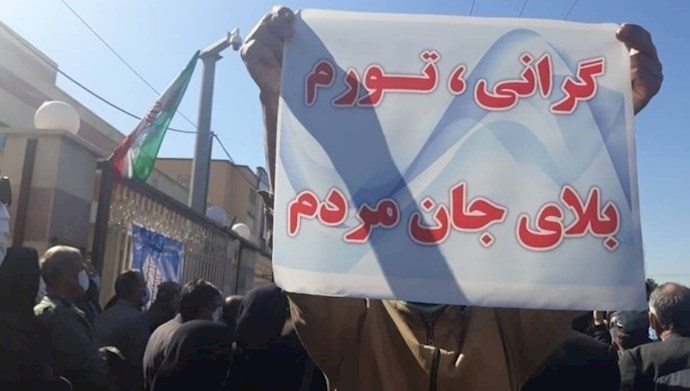Reporting by PMOI/MEK
Iran, March 1, 2021—On February 28, retirees, pensioners, and welfare recipients held rallies in more than a dozen cities across Iran for the fourth time in February. Protesters blamed the government for inaction regarding their dire living conditions and low pensions.
They vented their anger over the regime’s indifference about their dilemmas. In recent years, given the regime’s mismanagement and systematic corruption, many families are now living in poverty and dire circumstances.
The protesters chanted:
“We are fed up with this injustice,” “No nation has experienced such injustice,” “High prices and inflation are the people’s problem,” “Retirees demand salaries based on the inflation rate,” “Stellar salaries [for government officials], public misery,” and “Promises are enough, our pockets are empty.”
In the past weeks, other sectors of the society held similar gatherings in different cities, including:
-Contract teachers, janitors of public schools, and retirees of the Steel and Mine Industry from Isfahan province rallied in front of the Parliament (Majlis) in Tehran.
-Workers of the Markazi province-based HEPCO factory in Arak city, protesting the government’s failure to settle the factory’s debts and refrain from resuming the production cycle.
-Locals in the city of Sanandaj, Kurdistan province, protesting to Vice-President Eshagh Jahangiri for the government’s failure to resolve their dilemmas.
-People from the village of Chulab Kouchesfahan near the city of Rasht in Gilan province protesting the measures by state-backed institutions that are destroying their local environment.
-Local professionals of Petrochemical Plant in Ilam province
Notably, the abovementioned rallies were part of ongoing protests in different provinces. According to activists, not a day goes by without protests in Iran. And more importantly, the latest round of protests by pensioners took place while demonstrations across the Sistan and Baluchestan province in protest to the killing of fuel porters have been ongoing for a week.
Iranians Continue Protests Despite Bloody Suppression in November 2019
The continuation of protests heralds a new round of nationwide protests like November 2019, when gas prices sparked protests in around 200 cities across the country within a few days. A new round of protests is the authorities’ primary concern.
However, oppressive and plundering policies have left no choice for ordinary Iranians but to protest and launch uprisings to obtain their inherent rights. In such circumstances, officials frequently warn each other over the upcoming demonstrations and do their best to delay them.
“The people’s purchasing power has decreased. Many people are unable to buy basic goods like shampoo, face masks, and even eggs and bread. The people’s economic power has declined, pushing the middle-classes into poverty. If today some have been forced to buy bread on credit, we should look for money that has exited the country by the Aghazadehs [officials’ children],” according to a February article published in the state-controlled Arman newspaper.
These realities and public anger sounded alarm bells for officials. “In the province, [you] should prevent all issues that lead to or exaggerates discontent. Sometimes, a minor issue can severely spread and expand, and thus create problems… we must avoid creating this increase in protests,” said Interior Minister Abdolreza Rahmani Fazli during his visit to Ardabil province on February 21, according to a report wired by the semiofficial ILNA news agency.
“Currently, discontent is the main content shared on the internet and social media platforms, and the country may face the risk of an unbridled increase in public hatred,” according to a February 13 piece published by the state-controlled Arman daily. In other words, state-run media and officials are profoundly concerned about the society’s general readiness for protests and uprisings.
Saravan Protests Signal Powder Keg
Nonetheless, the recent uprising in Sistan and Baluchestan and people’s resistance against oppressive forces show that the regime’s estimation of the society’s restive atmosphere is correct. The people seek an opportunity to vent their anger at the regime.
This crisis has been rooted in the government’s failure to meet the people’s basic demands. “Inattention to demands and living conditions of the low-income class and those literally living in slums has resulted in deep crises. The [gas] protests in November 2019 were a specific example of such crises,” according to a February 20 article published by the state-controlled Mostaghel newspaper.
However, despite these warnings, the Iranian regime cannot curb further protests. “The [society’s] previous tolerance has dissipated,” according to a February 21 piece ran by the state-controlled Jahan-e Sanat daily. In this context, the government must either intensify suppression or resolve people’s dilemmas.
Iran’s society has shown that it would never succumb to autocrats’ desires despite the cruel suppression in November 2019. On the other hand, the regime is basically unable to resolve the people’s problems due to systematic corruption in the government and international isolation due to the regime’s malign behavior abroad.
In such circumstances, the regime must acquiesce to international calls to respect human rights, restrict its malign behavior in the Middle East, and stop its provocative ballistic missile programs. The people of Iran will welcome international pressure, leading the regime to decrease oppressive measures and pave the path for further protests.
“We should realize that such disputes, rivalries, and misconducts, alongside stress and anxiety from the coronavirus outbreak, severe restrictions, and overwhelming prices, all adding to public depression, are very dangerous,” according to a February 24 piece ran by the state-controlled Hamdeli daily. “Political rivalries are fruitless, and [officials] must consider this truth to deter irreparable risks,” the piece adds in a stark warning.
The daily later compared the regime’s current situation with former Iranian dictator Rezakhan’s era in 1920. “While tough authoritarianism are accompanied with the confiscation of accomplishments, rules, and ideals, such a process will result in mass anti-establishment riots,” the article concludes.





